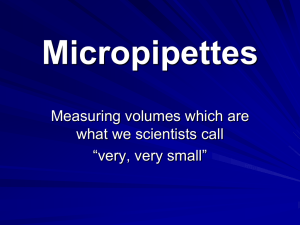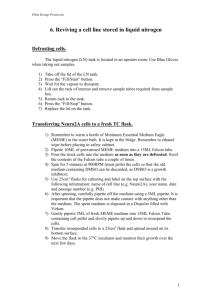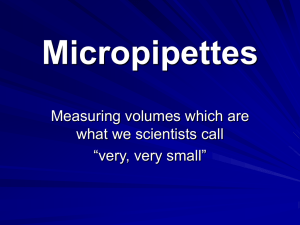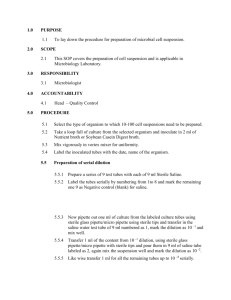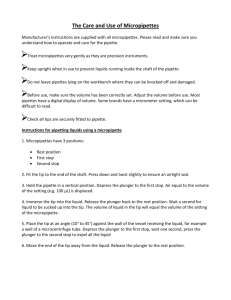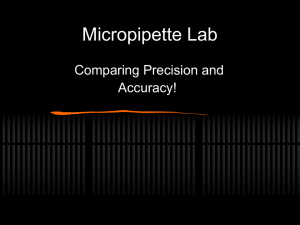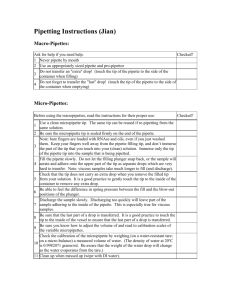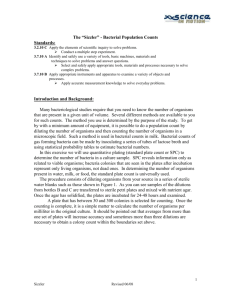Lab 1: Overview, Techniques and Safety
advertisement
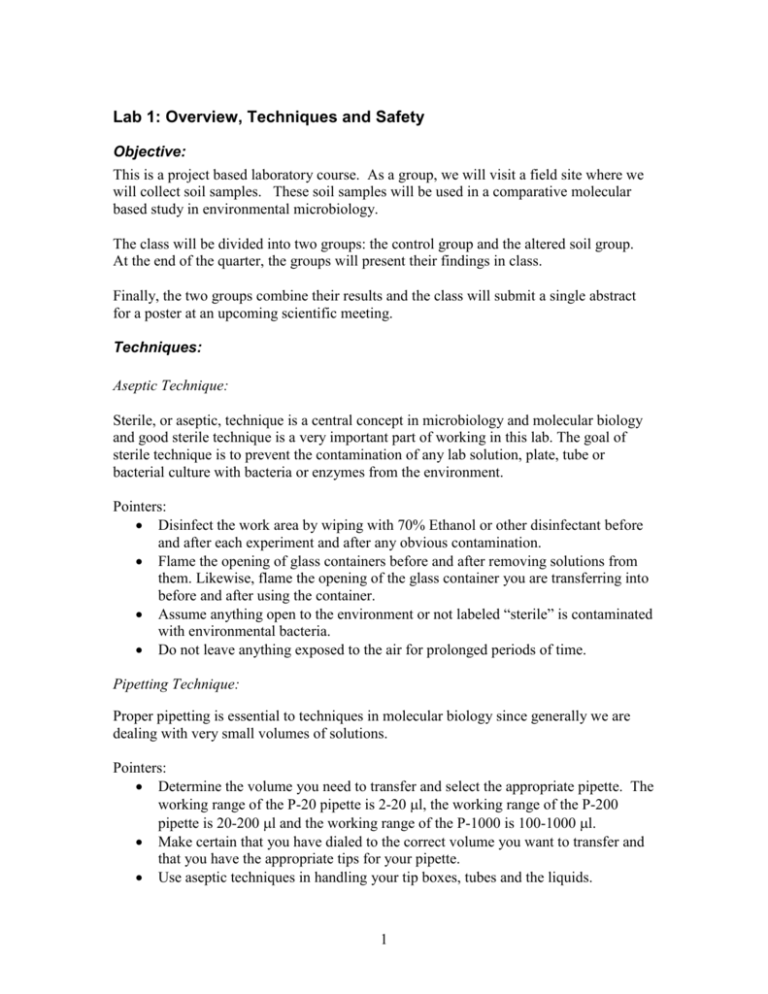
Lab 1: Overview, Techniques and Safety Objective: This is a project based laboratory course. As a group, we will visit a field site where we will collect soil samples. These soil samples will be used in a comparative molecular based study in environmental microbiology. The class will be divided into two groups: the control group and the altered soil group. At the end of the quarter, the groups will present their findings in class. Finally, the two groups combine their results and the class will submit a single abstract for a poster at an upcoming scientific meeting. Techniques: Aseptic Technique: Sterile, or aseptic, technique is a central concept in microbiology and molecular biology and good sterile technique is a very important part of working in this lab. The goal of sterile technique is to prevent the contamination of any lab solution, plate, tube or bacterial culture with bacteria or enzymes from the environment. Pointers: Disinfect the work area by wiping with 70% Ethanol or other disinfectant before and after each experiment and after any obvious contamination. Flame the opening of glass containers before and after removing solutions from them. Likewise, flame the opening of the glass container you are transferring into before and after using the container. Assume anything open to the environment or not labeled “sterile” is contaminated with environmental bacteria. Do not leave anything exposed to the air for prolonged periods of time. Pipetting Technique: Proper pipetting is essential to techniques in molecular biology since generally we are dealing with very small volumes of solutions. Pointers: Determine the volume you need to transfer and select the appropriate pipette. The working range of the P-20 pipette is 2-20 l, the working range of the P-200 pipette is 20-200 l and the working range of the P-1000 is 100-1000 l. Make certain that you have dialed to the correct volume you want to transfer and that you have the appropriate tips for your pipette. Use aseptic techniques in handling your tip boxes, tubes and the liquids. 1 Pick up a tip with your pipette and avoid contact between the tip and anything else in the laboratory aside from the sample you are working with. Depress the plunger to remove the air from you tip before submerging the tip into the solution. Immerse the tip into the liquid avoiding the container walls and bottom during sample aspiration. Pull the pipette straight out of the container after aspirating a sample. Do not touch the tip to the sides of the container. Transfer the solution you have drawn to the selected tube. Safety and Lab Rules: You must have your own lab notebook, tape, marker and coat. NO FOOD OR DRINK permitted in the laboratory. Use extreme caution with flammable materials around open flames. Wear gloves and eye protection when in the lab. The work area must be wiped down with disinfectant before and after each laboratory session. Report any spills or problems. Contaminated items and liquids must NOT be discarded in the trash or the sink. We will be working with Ethidium Bromide in the laboratory. Make sure to use extreme caution when working with this chemical. Other Useful Information: General prefixes: 10 deka (da) 2 10 hecto (h) 103 kilo (k) 6 10 mega (M) 9 10 giga (G) 1012 tera (T) 15 10 peta (P) 1018 exa (E) 10-1 10-2 10-3 10-6 10-9 10-12 10-15 10-18 deci (d) centi (c) milli (m) micro () nano (n) pico (p) femto (f) atto (a) Temperature conversions: Degrees Celsius (oC)= 5/9 [degrees Fahrenheit (oF) – 32] Degrees Fahrenheit (oF)= 9/5 [degrees Celsius (oC) + 32] Water Properties: Density at 0oC: 999.87 kg/m3 Density at 3.98oC: 1000.00 kg/m3 Density at 15oC: 999.13 kg/m3 Density at 25oC: 997.07 kg/m3 Volume conversions: 1ml = 1 cm3 1(m3) = 1,000,000 (cm3) 1liter = 1000 ml 2 Pre-lab Exercise 1: Answer the following questions: 1. What is the objective or goal of aseptic or sterile technique (1 point)? 2. If something is left exposed to the air for a prolonged time is it considered sterile? Why or why not (1 point)? 3. If using 70% ethanol, why is it not a good idea to keep your 70% Ethanol bottle near an open flame (1 point)? 4. One easy way to check the calibration on a pipette in the laboratory is to measure the weight of the volume of water you believe you are transferring since the density of water at room temperature (25oC) is known. Given this information, answer the following questions: a. How much does 10 l of water weigh (1 point)? b. How much does 55 l of water weigh (1 point)? c. How much does 1 ml of water weigh (1 point)? d. How much does 1 ml of refrigerated water weigh (1 point)? 5. Look up a Material Safety Data Sheet (MSDS) for Ethidium Bromide on the internet (Google is my favorite search engine but www.calstatela.edu has some resources also). Print the sheet, read it and attach it to this assignment (2 points). 6. What can you learn from this MSDS regarding handling of Ethidium Bromide (1 point)? 3 Laboratory Exercise 1: Supplies (per person unless otherwise stated): Bunsen burner Ethanol spray bottle Paper towels Flint Microcentrifuge tubes, 0.7, 1.5, 2.0 ml both flip tops and screw caps Pippettes, 0.5-10 l, 5-50l, 20-200l, 100-1000l (1 set per 2 persons) Pippette tips for all volumes Analytical balance (1 for entire lab) Petri plates with LB (4 per person), Petri plates with LB +Amp (100mg/L) (1 per person) Sterile 5mm glass beads (300 per student in test tube) Waste containers 37oC incubator Solutions: Sterile water (5ml per person) Protocol: 1. Before you begin, please remember to record everything you are doing in this lab manual. This applies to every lab class for the quarter. Record ALL mistakes or changes. 2. Sanitize your work area with 70% ethanol. 3. Light your Bunsen burner. 4. Label two LB plates with your initials and the words “open to air” and “open to air near flame.” 5. Place these plates open to the air in their respective locations for the duration of the class. 6. Touch the surface of one LB plate and one LB +Ampicillin plate with your bare hands. 7. Label these plates with your initials and the words “touched.” 8. Pipette 2 l, 5l, 10l, 25l, 50l, 200l, and 1ml into sterile pre-weighed and pre-labeled microcentrifuge tubes. 9. Record the weight of the water in the microcentrifuge tubes. 4 10. Aseptically transfer 100 l of sterile water to one LB petri plate. 11. Use sterile glass beads to spread the water onto the plate. (instructor demo) 12. At the end of class, cover all your exposed plates and place them in the 37oC incubator (agar side up). Lab notes: Sample Weight Sample 2 l 50 l 5 l 200 l 10 l 1000 l or 1 ml 25 l 5 Weight Laboratory Report 1: 1. Did you observe any difference between the “open to air” and “open to air near flame” LB plates? Describe (3 points). 2. Did you observe any difference between the LB and LB+Ampicillin “touched” plates? Describe (3 points). 3. What error would result in the following plate when using sterile beads (assume 100l of a water sample had been plated then incubated overnight)? (3 points) 4. What are the working ranges for the P-1000, P-200, and P-20 pipettes (3 points)? 6 5. If the automatic pipette you were using had the following numbers showing: 0 9 2 a. What volume would you be dispensing if you were using a P-20 pipette (1point)? b. What volume would you be dispensing if you were using a P-200 pipette (1 point)? c. What volume would you be dispensing if you were using a P-1000 pipette (1 point)? 6. Tabulate the results of your water weighing exercise. Show one sample calculation for the density determination (10 points). Sample Weight (g) Density 2 l 5 l 10 l 25 l 50 l 200 l 1000 l or 1 ml 7 Units
